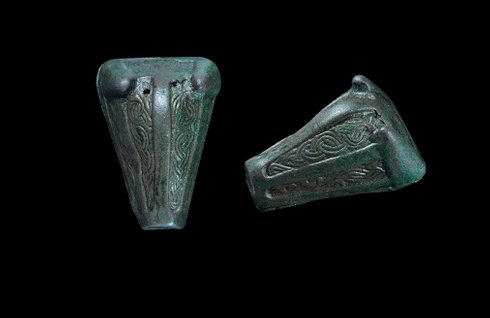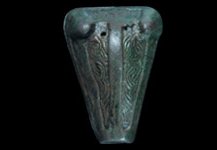Viking jewellry from the isle of Gotland - the animal head shaped brooch
This week's blog I address one of the specific feautures in Viking Age Gotlandic jewellry. The animal head shaped brooch.
These specific kind of brooches are often described as 'boar' or 'bear' head brooches.
Consulting Lena Ideström, curator at the Gotlands Museum in Sweden about this issue, she responded:
'If you translate the swedish word for these brooches "djurhuvudformade spännen" you get "animalhead shaped brooches"! I am afraid that I don´t know why the english speaking world has choosen boar and not bear. The type is very typical for Gotland and we have never had big game like bears here, maybe it has something to do with that.
If swedish people ask me what animal it is supposed to be I usually answer wild boar or bear, I would think both of them possible. And the fact that they look like animalheads to us does not necessarily mean that that was the meaning when they were made'.
Consulting Gunnar Andersson, senior curator at the The Swedish History Museum, he responded:
'I have never heard that they are called boar- or bear head brooches. In Scandinavian literature these Gotlandic brooches are simply called animal head-shaped brooches'.
These kind of brooches may be addressed as 'boar' perhaps because of the significance of the boar in Norse religion as an associate to the god Frey. A man called Friedrich Kruze had once compared them even with a horse head..
As we even do not know if these kind of brooches in the old days actually were called 'animal head shaped' let alone 'boar' or 'bear' head brooches, the use of animal head shaped brooches is useful, but by no means exclusive in my opinion.
The animal head shaped brooches were an exclusively Gotlandic type, used in pairs as part of the female dress brooches. Often together with the round boxshaped brooch, also an exclusively Gotlandic type. They were worn in pairs on tunic straps. They were in continious use from the 8th century until about 1150 A.D.
The island of Gotland specialized in the creation of richly ornamented box-shaped and animal-head brooches. The jewellery found in Viking-period graves shows that the Gotlanders shared in a Norse material culture, but had their own very distinctive regional identity.
The form of animal head shaped brooch with a separately-cast backplate is introduced around 900 AD. Many examples have been pierced to accept an attachment chain from which utensils could be hung in an ostentatious manner.
Specific details on the animal head shaped brooch:
A bronze boar-head brooch with separate backplate; the body formed as a hollow-cast case with upstanding ears and raised bar to the muzzle separating two panels of three-strand interlace ornament; to the sides and top, panels of scrolled tendrils; backplate attached by five studs, with rectangular slot, pin-lugs, round-section pin and integral catchplate; hole to the brow between the ears to attach a chain, small casting flaw to nasal. 66 grams, 55mm (2 1/4"). Very fine condition.
References:
A very nice cd with images from Gotlandic Viking Age jewellry can be found and here:
http://arkeodok.com/viking-artifacts/viking-jewellery-cd/
Article from the British Museum:
http://www.britishmuseum.org/explore/highlights/articles/g/gotland.aspx
Other: (the underlined titles are linking to a book store where these books can be ordered).
Brown, Katharine Reynolds, Migration Art 300 A.D. - 800 A.D. The Metropolitan Museum of Art, New York, 1995;
Brown, Katharine Reynolds, From Attila to Charlemagne, Arts of the Early Medieval Period in the Metropolitan Museum of Art, 2000 - p. 317, Gotlandic brooches.
Carlsson, Anders Djurhuvudformiga spännen och gotländsk vikingatid: text och katalog. Stockholm. 1983
Kovárová Lenka, The Swine in Old Nordic Religion and Worldview
Wixom, William D., Mirror of the Medieval World. 1999
A lot of more images of animal head shaped brooches can be found in publications, books and on the internet, so this is a very select catalogue.
Thomas Kamphuis, June 22th 2015.
Well. I could have been with these stones until after dark, but as my wife wanted to travel on.. well.. I see you again, some day, hogback stones from Gosforth. And if you happen to be there one day, do not forget that monument on the outside...
Further on with the Cumbrian hogbacktour !
In - yes, luckily again in - St. Peter's church in Heysham, there is a truly beautiful hogback stone. The guide told us, it had been studyied by Thor Ewing, a writer, in 2000. in 'Understanding the Heysham hogback' A tenth century sculpted stone monument and its context (link), Thor Ewing tells in detail what he dicovered on the both sides of this hogback stone.
Just being brought in the church as late as the 1970's accompanied with some protest here and there among the church visitors, considered as being a token of old paganism, it had been remarkably nice preserved, and a lot of detail can be seen, still. Truly worthwile a visit.
I had a small debate with the guide in the church if the - zoomorphic, in my opinion - faces on the sides were lions (or hippo's). The guide doubted if the vikings could have known about lions. Well I guess so, concerning the runes on the Ancient Greek lion statue at the Arsenal, Venice. For example. Vikings did travel south..
But when he told me he was doubting the vikings 'discovered' (as the native inhabitants were of course, in the first place) America before Columbus, I decided to rest my case..
One has to know when to start and to end a conversation ..
Just discovered the book in a bookstore written by Geoff Holder - The guide to the mysterious Lake District, I knew there had to be another hogback stone in Lowther, St. Micheal's Church. With a promising image described in the text of 'a naval and a land-based force of shield-bearing vikings above a fish and what might be a coiled sea serpent. On the reverse is a row of female figures with snakes, possibly a representation of the hideous hag Hel'. Wow. If that did not sound as a true pagan promised land ..
Not complaing too much after all we have seen, this visit was the dissapointing one of them all. But if you wife states 'I am happy to have seen them' and I am answering 'Measuring is knowing' and the even more obligate verb 'handling 'if we did not see it at all, we wouldn't have known anything at all of how they were looking' the glass was again half full, at the last day of our journey..
The hogback stone appeared to be just being tolerated within the entrance segment part of the church. As something you never use anymore but you do not throw away - entirely. That sort of feeling emerged when seeing this hogback asylum seekers.. Bed, bath and bread, ás we say in Dutch, but no luxury at all and standing on some outcuts of wood, you would balance the table with at home..
Come on, St. Micheal's Church.. care a bit more of your 'children' !
This hogback stone was moved in the church in 1907. Hogback stones layed partially buried in the churchyard before it was dug up and moved into the church.
The promising depiction of a longship - as certainly can be seen after some studying - see http://vikingminds.co.uk/pages/longship
we have missed !
The stone itself is (157 x 50 x 30 cm) and very worn.
The hogback stones in Cumbria - very diverse in quality, but everyone worth a visit ! Especially on a gloomy day in late October ...
The churches to visit - see photos of resp. St. Andrew's church in Penrith, St. Mary's church in Gosforth, St. Peter's church in Heysham and St. Micheal's church in Lowther.
Did I miss out on another one in Cumbria ? Let me know !
In a next blog I will take you to four - still remaining utterly mysterious- statues 'guarding' the graveyard of St. Andrew's church in Dacre..
For the last blog of October 9th see this link.
References: (as always, links to where the books can be ordered are attached).
Edwards, B.J.N. Vikings in North West England - The artifacts (1998);
Emery, Gordon, CURIOUS CUMBRIA, The Lake District & Beyond: A celebration of Cumbria (2023)
Ewing, T. 'Understanding the Heysham hogback' A tenth century sculpted stone monument and its context ;
Hall, R. Viking Age archaeology in Britain and Ireland (first printed 1990, reprinted with amendments in 1995);
Holder, G. The guide to the mysterious Lake District (2009)
possibly also (as there within the part of Cumbria dealing with Carlisle, the Eden Valley, Barrow-in-Furness, Whitehaven and the west coast is being dealed with)
Holder, G. Paranormal Cumbria (2010)
http://vikingminds.co.uk/pages/longship

